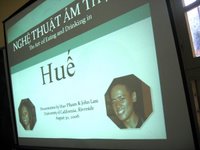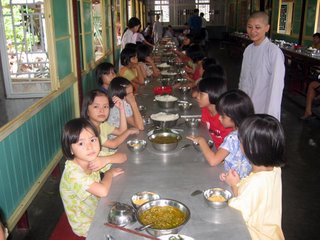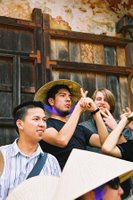
This Friday is the first day of three on the road north of Hue to the former border or "demilitarized zone" that once divided North and South Vietnam. For Friday, we traveled to visit to main sites, one the Nguyen era (1820 CE) citadel in Quang Tri that was the scene of the largest offensive in the war, the 1972 Easter Offensive, and then on to these tunnels just north of the DMZ where an entire village lived underground to avoid shelling from US ships just offshore. Before getting to Quang Tri we stopped at this shell of a former church that has been left as a reminder of the destructiveness of the war in this region. Especially from 1968-1973, the area suffered from some of the worst bombing and fighting of the entire war. Here Darin stands with a staff person, Loc, from Hue University.
 The museum at Quang Tri had a lot of archival photographs such as this one depicting what the small city and old citadel, not much different from the area where we are staying now, was reduced to rubble after three months of terrible fighting, over 40,000 killed, and over 1,000 US bombing missions. The citadel was the center for this fighting, where the People's Army nearly succeeded in not only taking Quang Tri but also continuing their drive south to take Hue.
The museum at Quang Tri had a lot of archival photographs such as this one depicting what the small city and old citadel, not much different from the area where we are staying now, was reduced to rubble after three months of terrible fighting, over 40,000 killed, and over 1,000 US bombing missions. The citadel was the center for this fighting, where the People's Army nearly succeeded in not only taking Quang Tri but also continuing their drive south to take Hue.
 After a brief lunch in the town of Dong Ha, we continued north towards the invisible 17th Parallel that runs through the former DMZ. Just south of this line ran a line of bunkers and forts all the way from the coast 60 miles inland to the Lao border. It was often called the McNamara Line. It included a whole array of electronic and infra-red surveillance equipment for detecting movement across the area. Now a monument stands commemorating this spot at which many people died trying to cross into South Vietnam to fight the war. Andrew, Anna and Darin stand in front, looking very socialist realist.
After a brief lunch in the town of Dong Ha, we continued north towards the invisible 17th Parallel that runs through the former DMZ. Just south of this line ran a line of bunkers and forts all the way from the coast 60 miles inland to the Lao border. It was often called the McNamara Line. It included a whole array of electronic and infra-red surveillance equipment for detecting movement across the area. Now a monument stands commemorating this spot at which many people died trying to cross into South Vietnam to fight the war. Andrew, Anna and Darin stand in front, looking very socialist realist.
 From there we then arrived at the Hien Luong River where a lone bridge served as a kind of diplomatically protected connection point between north and south during most of the war. This was also where prisoners of war from both sides were frequently released in the prisoner exchanges that commenced in 1970 or 71.
From there we then arrived at the Hien Luong River where a lone bridge served as a kind of diplomatically protected connection point between north and south during most of the war. This was also where prisoners of war from both sides were frequently released in the prisoner exchanges that commenced in 1970 or 71.
 Our last stop for the day was the fishing village of Vinh Moc just north of the river in the DMZ. Beginning in 1967, US Navy ships pounded this part of the northern coastline to prevent supplies and troops from making it to South Vietnam. So people responded by putting their entire village underground in a network of tunnels that included undeground toilets, hospitals, meeting rooms, and living quarters. Oh yeah, and the whole area is not rock but clay. They carved these tunnels all out of clay. Here the group poses at one of the entrances into the tunnels.
Our last stop for the day was the fishing village of Vinh Moc just north of the river in the DMZ. Beginning in 1967, US Navy ships pounded this part of the northern coastline to prevent supplies and troops from making it to South Vietnam. So people responded by putting their entire village underground in a network of tunnels that included undeground toilets, hospitals, meeting rooms, and living quarters. Oh yeah, and the whole area is not rock but clay. They carved these tunnels all out of clay. Here the group poses at one of the entrances into the tunnels.
 We descended into the tunnels over 200 feet under the surface with a local guide. I am pictured sitting in one of the small holes shooting off the main tunnel where a family of three would have lived. A few people got pretty freaked out by the tight conditions, but once we got used to the darkness, it wasn't too bad. Still, I don't think I'd want to spend a night in there, especially not if B52's were dropping bombs on top of me.
We descended into the tunnels over 200 feet under the surface with a local guide. I am pictured sitting in one of the small holes shooting off the main tunnel where a family of three would have lived. A few people got pretty freaked out by the tight conditions, but once we got used to the darkness, it wasn't too bad. Still, I don't think I'd want to spend a night in there, especially not if B52's were dropping bombs on top of me.
 After a long sweaty day of war tourism, we finished our day where else but the beach, a beautiful beach just south of Vinh Moc. Anna, Andrew, Xuan Anh and I enjoyed the sand while the tour guide, the driver, and Mr. Loc walked on to some beachside restaurant stands down the way.
After a long sweaty day of war tourism, we finished our day where else but the beach, a beautiful beach just south of Vinh Moc. Anna, Andrew, Xuan Anh and I enjoyed the sand while the tour guide, the driver, and Mr. Loc walked on to some beachside restaurant stands down the way.






 out with a Christian rock song in Vietnamese. Andrew presented a summary of his research and practice of Vietnamese traditional martial arts, while Connie and Miguel presented ideas from their paper on how the past is remembered in Hue. Collin entertained us with a brief tour of American nationbuilding efforts in Vietnam's past after John and Hue gave us an exciting, musical powerpoint on Hue's special cuisine. Gini closed out the affair with four very tranquil yet exciting songs that she learned to play on the dan bau instrument pictured here. We concluded the day with an ice cream party at one of the biggest cafes in Hue that serves this amazing array of French style ice cream and sorbet. The Vietnamese language teachers Huy, Huong, Phuong and Ngoc joined us.
out with a Christian rock song in Vietnamese. Andrew presented a summary of his research and practice of Vietnamese traditional martial arts, while Connie and Miguel presented ideas from their paper on how the past is remembered in Hue. Collin entertained us with a brief tour of American nationbuilding efforts in Vietnam's past after John and Hue gave us an exciting, musical powerpoint on Hue's special cuisine. Gini closed out the affair with four very tranquil yet exciting songs that she learned to play on the dan bau instrument pictured here. We concluded the day with an ice cream party at one of the biggest cafes in Hue that serves this amazing array of French style ice cream and sorbet. The Vietnamese language teachers Huy, Huong, Phuong and Ngoc joined us.











































